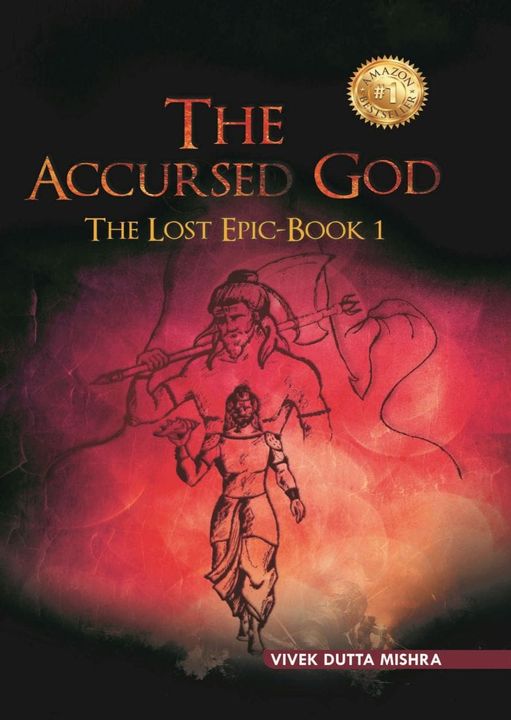The battle of Kurukshetra is nearing its end. Bhisma lies, half-dead on his bed of arrows, waiting for death to embrace him. His entire life has been a series of sacrifices, vows, and responsibility. Yet, there is one last task that he has left, which he is determined to finish before breathing his last…
It is to tell his side of the story. And to none other than Vasudev Krishna. How it all began with the rivalry between his father Kuru Emperor Shantanu and Panchal King Somark; why he really sacrificed his throne and how he became Bhishma from Devavrata. Born as the son of Bhagirathi and Shantanu, how he came to be the most feared warrior of his time. Most of all, was his blessing of ichha mrityu truly a blessing…or a curse?
However, The Accursed God doesn’t dwell on Bhishma alone. With each chapter, the perspective gradually shifts from Bhishma to other characters like Amba to a young Jarasandha and later, Dhritarashtra and Pandu before coming back to Bhishma, thus completing a full circle.
The new perspective of Kuru-Panchal rivalry as the root cause of the Kurukshetra War is refreshingly progressive. The author has delved into the politics of the Mahabharata era, instead of going the much-trodden path of blaming women (aka, Draupadi) for such a grand-scale war. He has grasped the political climate of Aryavarta fairly well; in places, he tries to find rationale behind some of the magical elements in the epic as we know it. One example is the background story of Bhagirathi.
The Accursed God has its high moments and one of it is Dutt’s spectacular re-imagining of Amba’s Swayamvar. In Vyasa’s text, Amba and her sisters were abducted by Bhishma after a tumultuous fight at Kashi’s Swayamvar sabha. Later, Amba confessed her love for Shalva, and she was allowed to leave after which she was turned down by her former lover. Distraught, she proceeded to seek justice, taking shelter in her grandfather Hotravahana’s ashrama that led her to Parshuram.
Dutt re-imagines this story, and gives an intelligent and satisfying spin to Bhishma’s victory of the Kashi princesses. Unlike Vyasa’s Amba who was strong, yet helpless in the face of patriarchy and circumstances, Dutt carvas a feisty and sharp woman who strategizes her moves and puts forth her demands boldly in front of the whole of Aryavarta. This is a recurring theme throughout the novel, as we meet Gandhari, Kunti and Madri…each one resilient in their own beautiful way. Coming back, Dutt has portrayed the three characters – Amba, Bhishma and Shalva – with utmost caution, explaining their individual perspective, exposing their shortcomings, and yet vilifying none. As a result, we come to empathize with all three of them and this is truly a commendable feat.
Few other moments that deserve special mention are the fight between Bhishma and Jantu, the war of Chitrangada and the last battle between Pandu and Jarasandha — especially the second one with Chitrangada.
Bhisma’s character arc is neatly sketched, as he traverses through his life’s trials and tribulations, gradually transforming from a loving son to the indifferent patriarch as we know him. There are several other characters which are well-written such as Jarasandha and Pandu. But my personal favourite is the exploration of Dhritatashtra’s psyche towards the end of the book. The man here is no helpless blind victim of circumstances but one who treats his weakness as strength. Though visually impaired, he is far more resourceful than many others around him. Dutt’s re-imagining of Dhritarasthra-Gandhari alliance deserves mention here and the latter’s blindfolding moment induces goosebumps.
Dutt’s insights into life and history are interesting. Take for instance this quote:
Allow me to make a prediction, Vasudev — it would always be one, today, tomorrow or after thousands of years. The Shastras of the time may say anything, may create any rule, may even make provision for five hundred and fifty people to rule — only one would truly rule; others would either fall in line or would be just a distraction.
The book is replete with such gems. Also, kudos to the author’s niece for the lovely sketches.
The Accursed God is not without its shortcomings, though. The storytelling needs polish and shows signs of a debutante. There are many, many individual moments in the book which are fascinating to read. But when stitched together, the finished product appears a little tedious with too many characters having no apparent connection to one another. This is more pronounced in the first couple of chapters, where in places, the plot switches haphazardly between timelines, characters and narrators. For someone who doesn’t know the story of Mahabharata already, this can be a little confusing.
Some characters undergo rapid changes without a proper character arc, for instance, Ved to Vyasa. A little dissatisfying was Somark’s reasoning behind his hatred for the Kurus. However, beyond the initial chapters, (from chapter 5 to be specific), the plot thickens. One can see a rapid improvement in the narrative style. As a result, towards the end of the book, one ends up appreciating the author as the story comes to a satisfying conclusion.
The Accursed God has a promising premise. With a little improvement in storytelling and tight editing, this series has potential to win hearts. It portrays the politics of the Mahabharata era which has been less explored in literature related to the epic except by some eminent writers like Bhyrappa and recently, Krishna Udayshankar. If you are interested in understanding the political backdrop of Mahabharata, The Accursed God might open up a whole new perspective.
Image Courtesy: Goodreads
For more book reviews, please go here -> Book Reviews
